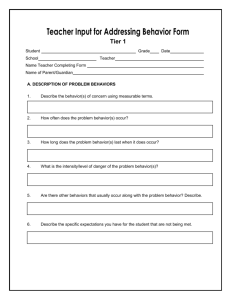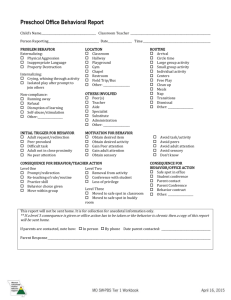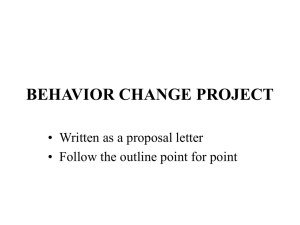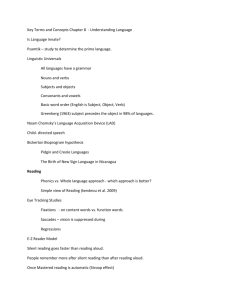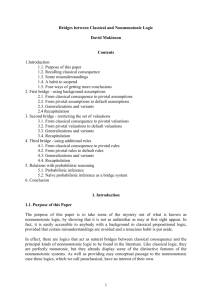Syntax & Semantics, Logic & Metalogic
advertisement
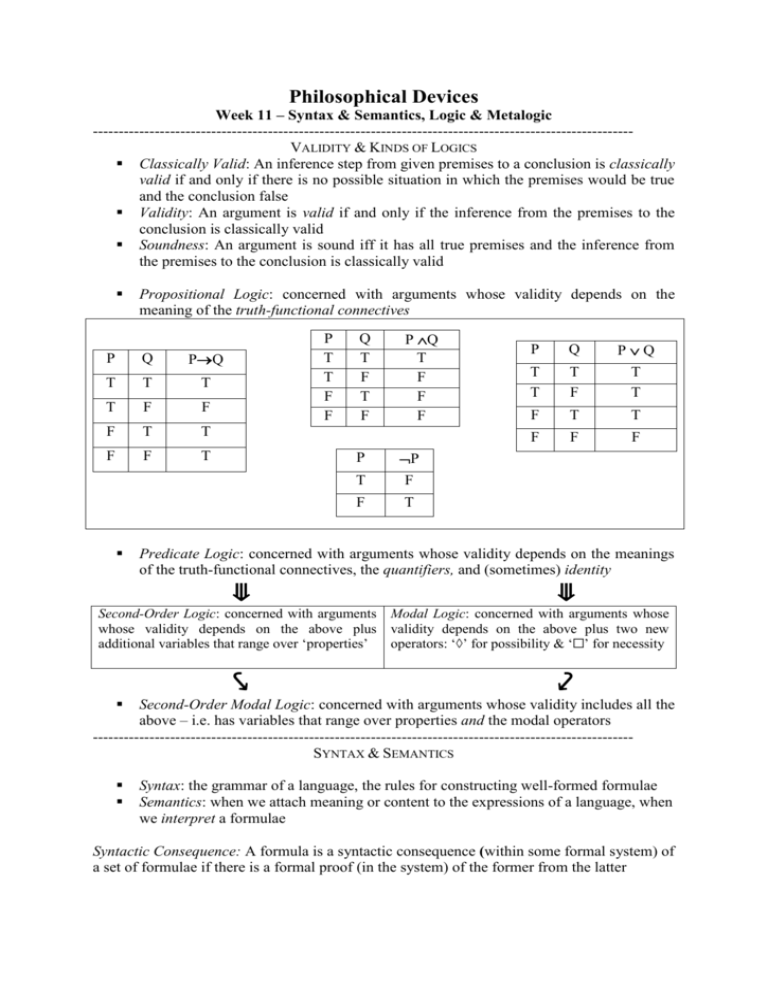
Philosophical Devices Week 11 – Syntax & Semantics, Logic & Metalogic --------------------------------------------------------------------------------------------------------VALIDITY & KINDS OF LOGICS Classically Valid: An inference step from given premises to a conclusion is classically valid if and only if there is no possible situation in which the premises would be true and the conclusion false Validity: An argument is valid if and only if the inference from the premises to the conclusion is classically valid Soundness: An argument is sound iff it has all true premises and the inference from the premises to the conclusion is classically valid Propositional Logic: concerned with arguments whose validity depends on the meaning of the truth-functional connectives P Q PQ T T T T F F F T T F F T P T T F F Q T F T F P Q T F F F T P F F T P P Q T T T F PQ T T F T T F F F Predicate Logic: concerned with arguments whose validity depends on the meanings of the truth-functional connectives, the quantifiers, and (sometimes) identity ⤋ ⤋ Second-Order Logic: concerned with arguments Modal Logic: concerned with arguments whose whose validity depends on the above plus validity depends on the above plus two new additional variables that range over ‘properties’ operators: ‘◊’ for possibility & ‘☐’ for necessity ⤥ ⤦ Second-Order Modal Logic: concerned with arguments whose validity includes all the above – i.e. has variables that range over properties and the modal operators --------------------------------------------------------------------------------------------------------SYNTAX & SEMANTICS Syntax: the grammar of a language, the rules for constructing well-formed formulae Semantics: when we attach meaning or content to the expressions of a language, when we interpret a formulae Syntactic Consequence: A formula is a syntactic consequence (within some formal system) of a set of formulae if there is a formal proof (in the system) of the former from the latter Philosophical Devices Example: A B ⊢ ¬B ¬A Week 10 2 Correlation & Causation Example: A B⊢ A; A B⊢ B Syntactic accounts of logical consequence rely on schemes using inference rules, such that the consequence follows simply from the connectives – what ‘A’ and ‘B’ mean doesn’t matter! Syntactic consequence does not depend on any interpretation of the formulae! Semantic Consequence: A formula is a semantic consequence (within some formal system) of a set of statements if and only if there is no model in which all members of the set are true and the formula is false; in other words, the set of the interpretations that make all members of the set true is a subset of the set of the interpretations that make true - P is a logical truth iff P is true in every interpretation; i.e., ⊨ P P is a contradiction iff P is false in every interpretation; i.e., ⊨P P1, P2…Pn ∴ C is valid iff there is no interpretation in which all of the premises are true and the conclusion is false; i.e., P1, P2…Pn ⊨ C. It is invalid otherwise P and Q are logically equivalent iff they are true in exactly the same interpretations as each other; i.e., both P ⊨ Q and Q ⊨ P Semantic consequence does depend on an interpretation of the formulae! The question: what is the relation between syntactic and semantic consequence? Is there an instance where they come apart – i.e. is every case of syntactic consequence a case of semantic consequence and vice versa? --------------------------------------------------------------------------------------------------------CLASSICAL LOGICS ‘Classical Logic’: refers to a class of logics, characterised by the following properties: - Law of the excluded middle: for any proposition P, either P is true, or P is true - Double negative elimination: if P is true, then P is true; if P is true, then P is true - Law of noncontradiction: contradictory statements cannot both be true in the same sense at the same time - Principle of explosion: ‘ex falso quodlibet’ – i.e., from a contradiction, anything follows - Monotonicity of entailment: the hypotheses of any derived fact may be freely extended with additional assumptions - Idempotency of entailment: the same consequences follow from many instances of a hypothesis as from just one - Commutativity of conjunction: conjuncts may switch places with each other, while preserving the truth-value of the resulting proposition - DeMorgan duality: The negation of a conjunction is logically equivalent to the disjunction of the negations & the negation of a disjunction is logically equivalent to the conjunction of the negations Philosophical Devices Week 10 3 Correlation & Causation o negation normal forms: any formula is equivalent to another formula where negations only occur applied to the non-logical atoms of the formula --------------------------------------------------------------------------------------------------------KINDS OF NON-CLASSICAL LOGICS Susan Haack (1974) offers three ways a logic can be non-classical: Extension: A logic L1 is an extension of L2 iff the class of well-formed formulae of L1 properly includes the class of wffs of L2, the class of theorems/valid inferences of L1 properly includes the class of inferences/theorems of L2, and the additional theorems/valid inferences of L1 all containing non-eliminable occurrences of L1’s additional vocabulary o Modal logic: extends classical logic with non-truth-functional operators Deviant: A logic L1 is a deviant logic iff the class of wffs of L1 and the class of wffs of L2 coincide, but the class of theorems/valid inferences of L1 differs from the class of theorems/valid inferences of L2 Quasi-deviant: A logic L1 is a quasi-deviant logic iff the class of wffs of L1 properly include the class of wffs of L2, and the class of theorems/valid inferences of L1 differs from the class of theorems/valid inferences of L2 not only in that L1 includes additional theorems involving (ineliminably) the additional vocabulary, but also in that the sets of theorems involving only the common vocabulary differ o Fuzzy logic: rejects the law of the excluded middle, allows as a truth value any real between 0 and 1 o Intuitionistic logic: rejects excluded middle, double negative elimination, & DeMorgan o Linear logic: rejects idempotency of entailment o Paraconsistent logic: rejects law of noncontradiction - Relevance logic: requires antecedent & consequent be relevantly related (note: also rejects monotonicity of entailment) - Dialethiasm: there are true contradictions! ---------------------------------------------------------------------------------------------------------

